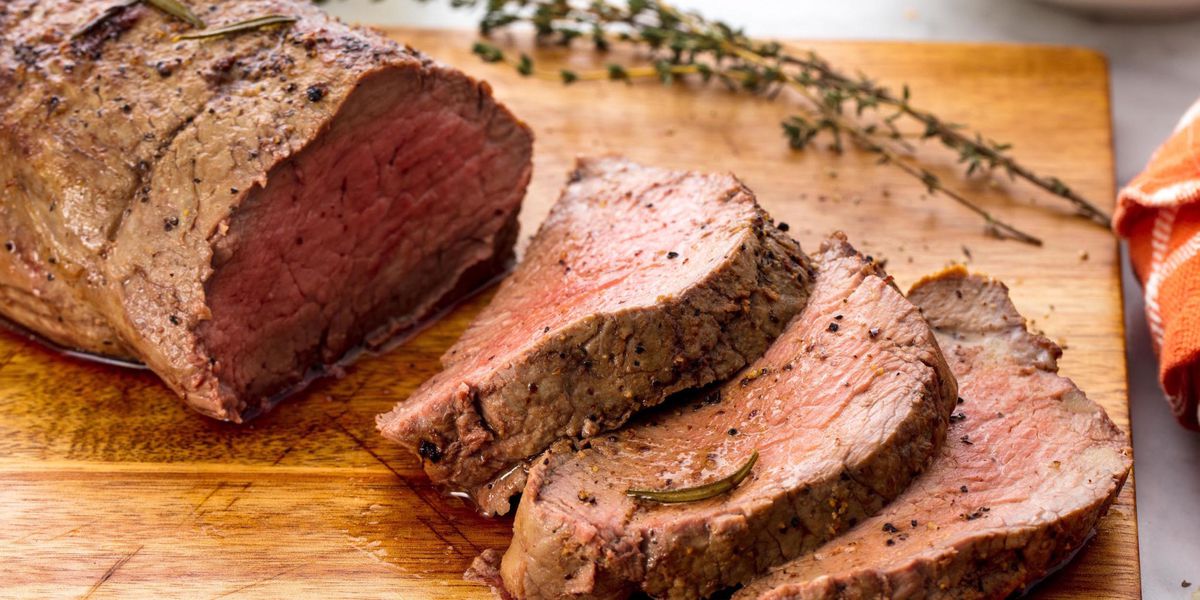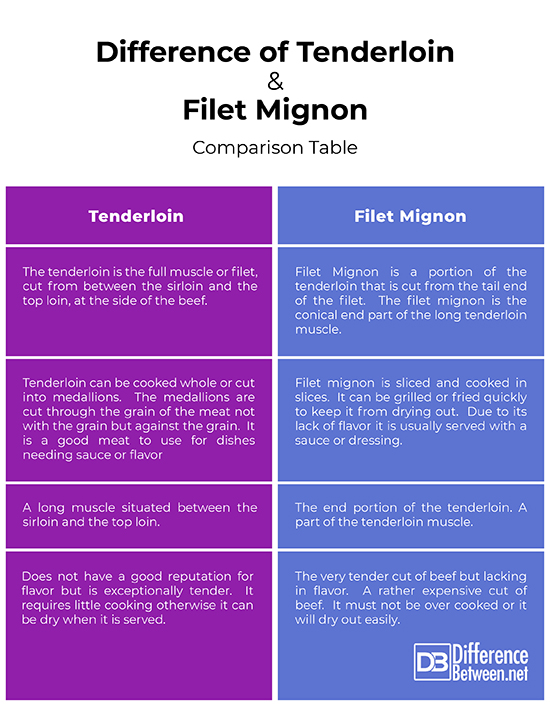Difference between Tenderloin and Filet Mignon
Tenderloin and filet mignon are both prime cuts of beef. They are found on the same part of the animal to be cut for consumption, by the butcher. The confusion comes from the fact that the tenderloin is the entire portion of meat taken from the animal’s side and the filet mignon is the portion of the tenderloin that is at the tip of the entire strip of meat. Therefore a filet mignon can be tenderloin, but strictly speaking the whole tenderloin should not called filet mignon. The filet mignon is just the conical tip of the tenderloin. The tenderloin is a long muscle that stretches from between the sirloin and the top loin. The filet Mignon is a small part of that muscle on the tip of the tenderloin.
What is Tenderloin?
Tenderloin is a muscle found between the sirloin and the top loin. It is a very tender portion of meat because it does not have much work to do in the form of exercise or weight baring for the animal. The tenderloin weighs up to 4 – 6 lbs and can be sold as a whole filet or in medallions, or rounds, cut across the grain of the tenderloin. Tenderloin can be sold as trimmed or untrimmed. The untrimmed tenderloin has some fat and a silver skin from the cow’s sides to be removed. Then it is ready to be cooked. The larger medallions in the middle are known as tornadoes and are cooked individually. The top end of the tenderloin is called the ‘Chateaubriand’ a meal for two people to share.
What are the Consumer Values of Tenderloin?
- Tenderloin is a very tender cut of beef.
- Tenderloin is a good steak for the barbecue because it has less fat and therefore causes less flare-ups on the fire. This reduces the chance of burning the meat.
- Tenderloin can be sliced and pan fried or roasted whole. Although it does not have the same flavor as other cuts it is still viewed as an expensive treat on the menu.
- Tenderloin goes well with different sauces and dressings.
- Tenderloin is the most frequently ordered steak off the menu at high end restaurants.
What is Filet Mignon?
Filet mignon is a cut of the tenderloin. It is often confused with the whole tenderloin because when the tenderloin is cut into medallions it is referred to as filet mignon. The name filet Mignon, correctly used, is the conical end part of the tenderloin. It can be evenly sliced into thick steaks that resemble medallions. The filet mignon is tender, but not reputed to have a great deal of flavor of its own. It goes well with different dressings and sauces and is one of the more expensive cuts of meat. The filet mignon should be marbled with strands of fat that add to its tenderness. Although mignon is a French word the French actually call that part of the tenderloin the Filet de Boeuf. Filet mignon is the name the French use to describe pork tenderloin. Filet mignon is not a chef’s favorite, because it is looked upon as tasteless and boring, but it is a popular menu choice.
What are the Consumer Values of Filet Mignon?
- Filet mignon is quick and easy to cook.
- Filet mignon is sliced into small rounds and dresses well with sauces and dressings.
- Chefs do not favor the filet mignon, but it is a popular cut of meat although expensive.
- The Filet mignon is a healthy choice because it is a lean meat.
- Filet Mignon is considered to be the ‘King of steaks’ but not everyone would agree with this statement because this cut lacks flavor.
Differences in the Cut and Serving of Tenderloin and Filet Mignon
-
The Cut of Beef:
Tenderloin and filet mignon are easily confused because they do come from the same muscle cut from the side of beef. The tenderloin can be seen as the whole piece of meat while the filet mignon is the portion that tapers down to a point at the end of the tenderloin. The tenderloin can be bought as a whole piece while the filet mignon is pieces cut in rounds from the tenderloin.
-
The type of Meat:
The tenderloin, and therefor the filet mignon, are lean cuts of meat with no bone. They have an element of marbled fat but are not fatty. Both of these cuts of meat are tender, but not as full of flavor as other cuts because they have no bone or real fat.
-
Presentation and Serving:
Tenderloin can be cooked as one whole piece and cut after it is cooked or it can be cut into medallions and cooked as individual small round steaks. The meat is best cooked quickly and served underdone to get the best flavor. The filet mignon steaks are sometimes wrapped in bacon and secured to give the meat more flavor and add the element of fat around the edge of the meat. The tenderloin and the filet mignon are great cuts of meat to use in dishes needing flavoring as the steaks are tender, but rather tasteless.
-
Preferences
There is no real preference for either of the two types of meat because they are both part of the tenderloin. Individuals may prefer the smaller slices of the filet mignon while others may enjoy the whole tenderloin being cooked or roasted as one piece.
Difference of Tenderloin and Filet Mignon: Comparison Table
Summary of Tenderloin verses Filet Mignon
- Tenderloin and Filet Mignon are really one and the same in terms of the cut of beef and the area that they are taken from on the animal.
- Both these cuts of beef are known for their tenderness and not really for their beef flavor. They do provide a really good meat option for adding sauces and dressing to and they are popular in restaurants.
- The confusion between the two cuts of meat is due to the tendency to call both by the name of filet mignon when the tenderloin is sliced. Slices from the end part of the tenderloin can be called filet mignon, but the remainder of the tenderloin is tenderloin. The whole tenderloin is what the butcher prepares from the whole carcass. The filet mignon is the sliced portion that should be referred to as filet mignon because it has been cut from the tail end of the tenderloin. Therefor the meat is tenderloin until the bottom section of the tenderloin muscle is reached and cut to make the filet mignon.
- The tenderloin can be divided into three different sections the filet mignon at the end tip and the Chateaubriand in the middle. The Chateaubriand is often a meal served for two. Finally the top end of the tenderloin is known as the butt end.
- A consumer can buy the whole tenderloin and slice it accordingly. They may call all their slices filet mignon but strictly speaking the filet mignon is only the ‘tail end’ of the tenderloin. The whole tenderloin can be roasted as a main dish, but it would not be referred to as filet mignon.
- Restaurants like to serve filet mignon and it is a popular cut of meat even though it is a bit expensive. Chefs do not find the tenderloin a desirable cut because they say it lacks flavor.
- Difference Between Lagoon and Bay - October 20, 2021
- Difference Between Futurism and Preterism - August 12, 2021
- Difference Between Dichotomy and Paradox - August 7, 2021
Search DifferenceBetween.net :
2 Comments
Leave a Response
References :
[0]Edmonson Paul. Meat dishes – filet Mignon. October 10th 2017. www.delishably.com. Pub delishably.com. Reviewed 3/12/2018.
[1]Lesley.T. Filet Mignon and tenderloin steak. 13.08.2001 www,chowhound.com/post/filet-mignon-tenderloin-steak. Pub. CBSinteractive. Reviewed 3.12.2018.
[2]Image credit: https://www.kansascitysteaks.com/dyn-images/pdp_hero/Filet-Mignon_cut_FH1-794c0fbb6666471f9882dcb0b7df32d2.jpg
[3]Image credit: https://hips.hearstapps.com/del.h-cdn.co/assets/17/38/2048x1024/landscape-1506010658-beef-tenderloin-delish.jpg?resize=1200:*




Good article however I noticed a couple of spelling errors. The word ‘bearing’ as in ‘weight bearing’ needs an ‘e’. The word ‘therefor’ is made good use of but that spelling is considered arcane. I do think the preferred spelling these days is ‘therefore’. Again an e.
This is not a spelling contest. This is about a summary tender lion verses filet mignon.